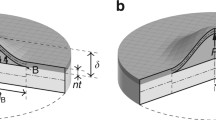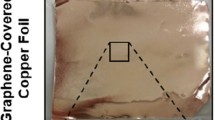Abstract
The effect of initial tension on mechanics of adhered graphene blisters is investigated by extending Hencky’s solution to cases with an initial tension. The system parameters including maximum blister deflection, pressure difference across the membrane, and critical delamination pressure under various initial tensions are modeled and calculated. The dependences of critical pressure on the radius and depth of etched microcavity are also demonstrated and compared with the previous work which does not consider the initial tension. The results show that the added adhesion energy between monolayer graphene membrane and SiO2 substrate can reach 0.0954 J/m2 with a reported maximum initial tension of 2.4 N/m taken into account, which accounts for 21.2 % of the measured average value 0.45 J/m2. Thus, the initial tension should be considered in further adhesion energy measurements of graphene/substrate interfaces.






Similar content being viewed by others
References
K.S. Novoselov, A.K. Geim, S.V. Morozov et al., Electric field effect in atomically thin carbon films. Science 306(5696), 666–669 (2004). doi:10.1126/science.1102896
Y.M. Lin, C. Dimitrakopoulos, K.A. Jenkins et al., 100-GHz transistors from wafer-scale epitaxial graphene. Science 327(5966), 662 (2010). doi:10.1126/science.1184289
Y. Xu, Z.D. Guo, H.B. Chen et al., In-plane and tunneling pressure sensors based on graphene/hexagonal boron nitride heterostructures. Appl. Phys. Lett. 99(13), 133109 (2011). doi:10.1063/1.3643899
A.D. Smith, F. Niklaus, A. Paussa et al., Electromechanical piezoresistive sensing in suspended graphene membranes. Nano Lett. 13(7), 3237–3242 (2013). doi:10.1021/nl401352k
S.E. Zhu, M.K. Ghatkesar, C. Zhang et al., Graphene based piezoresistive pressure sensor. Appl. Phys. Lett. 102(16), 161904 (2013). doi:10.1063/1.4802799
S. Park, R.S. Ruoff, Chemical methods for the production of graphenes. Nat. Nanotechnol. 4(4), 217–224 (2009). doi:10.1038/NNANO.2009.58
T. Mueller, F.N. Xia, P. Avouris, Graphene photodetectors for high-speed optical communications. Nat. Photonics 4(5), 297–301 (2010). doi:10.1038/NPHOTON.2010.40
J.S. Bunch, A.M. Van Der Zande, S.S. Verbridge et al., Electromechanical resonators from graphene sheets. Science 315(5811), 490–493 (2007). doi:10.1126/science.1136836
K.M. Milaninia, M.A. Baldo, A. Reina et al., All graphene electromechanical switch fabricated by chemical vapor deposition. Appl. Phys. Lett. 95(18), 183105 (2009). doi:10.1063/1.3259415
P. Li, Z. You, G. Haugstad et al., Acceptor deactivation in individual silicon nanowires: from thick to ultrathin. Appl. Phys. Lett. 98(25), 253103 (2011). doi:10.1063/1.3602924
Z. Zong, C.L. Chen, M.R. Dokmeci et al., Direct measurement of graphene adhesion on silicon surface by intercalation of nanoparticles. J. Appl. Phys. 107(2), 026104 (2010). doi:10.1063/1.3294960
J.S. Bunch, S.S. Verbridge, J.S. Alden et al., Impermeable atomic membranes from graphene sheets. Nano Lett. 8(8), 2458–2462 (2008). doi:10.1021/nl801457b
C. Lee, X. Wei, J.W. Kysar et al., Measurement of the elastic properties and intrinsic strength of monolayer graphene. Science 321(5887), 385–388 (2008). doi:10.1126/science1157996
S.P. Koenig, N.G. Boddeti, M.L. Dunn et al., Ultrastrong adhesion of graphene membranes. Nat. Nanotechnol. 6(9), 543–546 (2011). doi:10.1038/nnano.2011.123
N.G. Boddeti, S.P. Koenig, R. Long et al., Mechanics of adhered, pressurized graphene blisters. J. Appl. Mech. 80(4), 040909 (2013). doi:10.1115/1.4024255
R.A. Barton, B. Ilic, A.M. van der Zande et al., High, size-dependent quality factor in an array of graphene mechanical resonators. Nano Lett. 11(3), 1232–1236 (2011). doi:10.1021/nl1042227
C.Y. Chen, S. Rosenblatt, K.I. Bolotin et al., Performance of monolayer graphene nanomechanical resonators with electrical readout. Nat. Nanotechnol. 4(12), 861–867 (2009). doi:10.1038/nnano.2009.267
M.Y. Huang, T.A. Pascal, H.J. Kim et al., Electronic-mechanical coupling in graphene from in situ nanoindentation experiments and multiscale atomistic simulations. Nano Lett. 11(3), 1241–1246 (2011). doi:10.1021/nl104227t
L.D. Wang, J.J. Travis, A.S. Cavanagh et al., Ultrathin oxide films by atomic layer deposition on graphene. Nano Lett. 12(7), 3706–3710 (2012). doi:10.1021/nl3014956
H. Hencky, Über den spannungszustand in kreisrunden platten mit verschwindender biegungssteiflgkeit. Z. Math. Phys. 63, 311–317 (1915)
U. Komaragiri, M.R. Begley, J.G. Simmonds, The mechanical response of freestanding circular elastic films under point and pressure loads. J. Appl. Mech. 72(2), 203–212 (2005). doi:10.1115/1.1827246
J.J. Vlassak, W.D. Nix, A new bulge test technique for the determination of Young’s modulus and Poisson’s ratio of thin films. J. Mater. Res. 7(12), 3242–3249 (1992). doi:10.1557/JMR.1992.3242
K.T. Wan, Y.W. Mai, Fracture mechanics of a new blister test with stable crack growth. Acta Metall. Mater. 43(11), 4109–4115 (1995)
J.G. Williams, Energy release rates for the peeling of flexible membranes and the analysis of blister tests. Int. J. Fract. 87(3), 265–288 (1997). doi:10.1023/A:1007314720152
A.N. Gent, L.H. Lewandowski, Blow-off pressures for adhering layers. J. Appl. Polym. Sci. 33(5), 1567–1577 (1987). doi:10.1002/app.1987.070330512
J.U. Lee, D. Yoon, H. Cheong, Estimation of Young’s modulus of graphene by Raman spectroscopy. Nano Lett. 12(9), 4444–4448 (2012). doi:10.1021/nl301073q
J. Zabel, R.R. Nair, A. Ott et al., Raman spectroscopy of graphene and bilayer under biaxial strain: bubbles and balloons. Nano Lett. 12(2), 617–621 (2012). doi:10.1021/nl203359n
D. Metten, F. Federspiel, M. Romeo et al., Probing built-in strain in freestanding graphene monolayers by Raman spectroscopy. Phys. Status Solidi B 250(12), 2681–2686 (2013). doi:10.1002/pssb.201300220
D. Metten, F. Federspiel, M. Romeo et al., All-optical blister test of suspended graphene using micro-Raman spectroscopy. Phys. Rev. Appl. 2(5), 054008 (2014). doi:10.1103/PhysRevApplied.2.054008
A.L. Kitt, Z.N. Qi, S. Rémi et al., How graphene slides: measurement and theory of strain-dependent frictional forces between graphene and SiO2. Nano Lett. 13(6), 2605–2610 (2013). doi:10.1021/nl4007112
Author information
Authors and Affiliations
Corresponding author
Rights and permissions
About this article
Cite this article
Liao, P., Xu, P. Effect of initial tension on mechanics of adhered graphene blisters. Appl. Phys. A 120, 1503–1509 (2015). https://doi.org/10.1007/s00339-015-9344-4
Received:
Accepted:
Published:
Issue Date:
DOI: https://doi.org/10.1007/s00339-015-9344-4




